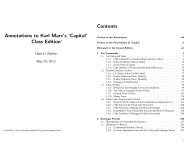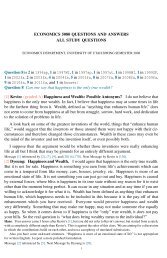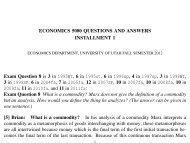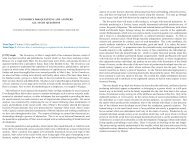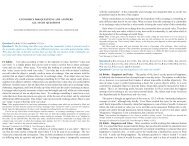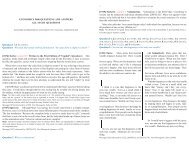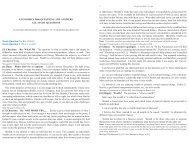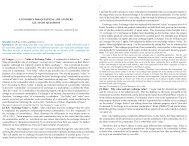Question 1 What did Marx mean with his formu - University of Utah
Question 1 What did Marx mean with his formu - University of Utah
Question 1 What did Marx mean with his formu - University of Utah
Create successful ePaper yourself
Turn your PDF publications into a flip-book with our unique Google optimized e-Paper software.
U <strong>of</strong> <strong>Utah</strong> Econ 5080 2007fa 87<br />
flashing was a signal <strong>of</strong> a special relationship between him and that specific person. He was<br />
confused, however, when subsequent cars kept doing the same thing. It was after several<br />
cars flashed their lights that he realized what had happened – <strong>his</strong> own lights were <strong>of</strong>f. Hans<br />
understood that the flashing <strong>did</strong> not signify a special relationship between him and the other<br />
cars, but merely was the similar act <strong>of</strong> different cars telling him the same thing about himself.<br />
It was something about Hans that caused the cars to flash, not a special relationship Hans<br />
had <strong>with</strong> them.<br />
T<strong>his</strong> illustrates how <strong>Marx</strong> sees the joint work <strong>of</strong> other commodities (i.e. other cars) in expressing<br />
the value (i.e. Hans’s lights <strong>of</strong>f) <strong>of</strong> one commodity. For <strong>Marx</strong>, the exchange-value<br />
is not determined by a special relationship between two goods. It is an exterior expression <strong>of</strong><br />
the congealed abstract labor in the commodity. It is imperative to understand that for <strong>Marx</strong>,<br />
commodities don’t get value from each other. The market relations between commodities<br />
merely give them a stage to showcase their intrinsic values. Deere [2002fa:75] explained<br />
the joint work <strong>of</strong> the commodities using <strong>Marx</strong>’s theory <strong>of</strong> the Simple and Expanded form<br />
<strong>of</strong> value. In the Simple form, all <strong>of</strong> the commodities align their value <strong>with</strong> a common commodity.<br />
In <strong>Marx</strong>’s writings, he uses the gold standard as an example. Linen, wheat, iron and<br />
all other commodities align their values against that <strong>of</strong> gold. Then t<strong>his</strong> “commodity commonality”<br />
becomes the measuring stick which expresses value in the world <strong>of</strong> commodities.<br />
Hans [2003fa:117] further distinguishes t<strong>his</strong> joint effort <strong>of</strong> selecting one use-value for all<br />
commodities to express their value in from the separate work <strong>of</strong> each commodity to merely<br />
express its value in some way. Moreover, as Neolib [2003fa:224-7] explains, the market <strong>of</strong><br />
exchange could not function <strong>with</strong>out t<strong>his</strong> joint work. “In order to facilitate exchange, it is<br />
self-evident why commodities cannot express themselves on an individual basis. The market<br />
demands a uniform commodity in which to express value in, as otherwise value would<br />
become subjective.”<br />
Hans: Excellent. But if all commodities express their values in a common commodity t<strong>his</strong> is not the Simple form<br />
<strong>of</strong> value but the General form <strong>of</strong> value.<br />
Message [215] referenced by [226]. Next Message by Ricky is [226].<br />
[224] Jill: In my first response to t<strong>his</strong> question I was possibly too detailed in my example<br />
and <strong>did</strong> not include the main point. The joint work <strong>of</strong> all commodities is necessary to<br />
express the value <strong>of</strong> one commodity because they all must use the same value system. A<br />
value must be placed on each commodity based on the materials and labor that went into<br />
creating it. The society must have an agreed upon measure <strong>of</strong> worth in order for anything<br />
to have an accurate value. For example, a society that chooses to measure the value <strong>of</strong> their<br />
commodities in feathers would then have a standard item to relate the labor and material<br />
cost to and commodities in that society would be exchanged much more fairly than another<br />
society in which eggs may be valued in feathers but linen is valued in gold. There must be a<br />
common measure for which all items are held accountable.<br />
Next Message by Jill is [413].<br />
[228] Jeff: In the original answer that was proposed on the exam, an incorrect approach<br />
was taken to explain the concept <strong>of</strong> joint work on all commodities.<br />
The core <strong>of</strong> t<strong>his</strong> concept is that not everything can be equated, value wise, easily or at all.<br />
Therefore, there must be one set commodity in which all things can be equated to. T<strong>his</strong> set<br />
commodity is called the general equivalent. So looking at the t<strong>his</strong> scenario, the joint work is<br />
88 2007fa Econ 5080 U <strong>of</strong> <strong>Utah</strong><br />
found in the efforts that are put into the commodity to make it what it is as well as the general<br />
equivalent itself. T<strong>his</strong> is due to the key component <strong>of</strong> the argument that it is necessary to<br />
have one centralized unit <strong>of</strong> comparison to be able to properly assess value relative to other<br />
commodities. Therefore, <strong>with</strong> the central unit <strong>of</strong> measure and having all other commodities<br />
compared to t<strong>his</strong> one general equivalent, one would be able to see the joint work that is<br />
required to be able to properly asses the value <strong>of</strong> a commodity.<br />
T<strong>his</strong> analysis is the correct one <strong>of</strong> the concept <strong>of</strong> joint work to properly express the value<br />
<strong>of</strong> one commodity. It is based on centralizing the measurement <strong>of</strong> value to one commodity<br />
and having all other commodities compared to it. When t<strong>his</strong> is done, joint work <strong>of</strong> all the<br />
commodities allows for a proper valuation <strong>of</strong> a commodity.<br />
Next Message by Jeff is [410].<br />
[234] Nogi: Joint work for value <strong>of</strong> one. <strong>Marx</strong> seems to equate t<strong>his</strong> question to the<br />
amount <strong>of</strong> labor put into the joint commodities in order to express the value <strong>of</strong> one commodity.<br />
In the example <strong>Marx</strong> uses he says the commodities not only qualitatively equal as values<br />
in general but also as values whose quanities can be compared. <strong>What</strong> I think he <strong>mean</strong>t in<br />
regaurds to t<strong>his</strong> question is that the value can be determined by the labor put in to produce<br />
the commodity but all the joint commodities will have varying degrees <strong>of</strong> value because different<br />
amounts <strong>of</strong> labor was put into them. Therefore t<strong>his</strong> must be taken into account when<br />
determining the value <strong>of</strong> one commodity from its joint commodities.<br />
Hans: Wrong. <strong>Marx</strong> is discussion the expression <strong>of</strong> value, not its determination. There are a number <strong>of</strong> answers<br />
like yours in the archives, and I always comment that they are wrong.<br />
Next Message by Nogi is [349].<br />
[235] Amy: Expression <strong>of</strong> all commodities values by one commodity. In order to<br />
exchange a commodity, one must first recognize the value <strong>of</strong> the commodity. In the simple<br />
form <strong>of</strong> value one recognizes that 20 yards <strong>of</strong> linen is worth 1 coat. T<strong>his</strong> establishes that 20<br />
yards <strong>of</strong> linen has the same value (abstract labor) as 1 coat. Then to progress to the expanded<br />
form <strong>of</strong> value one has to recognize not only is 20 yards <strong>of</strong> linen = 1 coat but that it is also<br />
equal to 10 lbs. tea or = 40 lbs. c<strong>of</strong>fee or = 1 quarter <strong>of</strong> wheat or = 2 oz. <strong>of</strong> gold or = 1/2 ton<br />
<strong>of</strong> iron or = etc. (Capital, p 155) The joint work <strong>of</strong> all commodities establishes the general<br />
form <strong>of</strong> value where X amount <strong>of</strong> Commodity A = W amount <strong>of</strong> Commodity B and Z amount<br />
<strong>of</strong> Commodity C also = X amount <strong>of</strong> Commodity A. All commodities have to first express<br />
their value in the simple form before they can express their value in the expanded form.<br />
Once all commodities have been expressed in expanded form then they all have to agree<br />
on one commodity that will represent them all. One would want to choose a commodity<br />
that has consistent quality and quantity, for example gold. Different amounts <strong>of</strong> gold equal<br />
different amounts <strong>of</strong> different commodities. It takes the joint work <strong>of</strong> all commodities to<br />
determine a general expression because all commodities have to express their value in that<br />
said commodity and every new commodity that comes onto the market must also express<br />
their value in that commodity. By having one commodity that expresses the value <strong>of</strong> all<br />
other commodities it makes it easier to compare the value <strong>of</strong> commodities.<br />
Hans: You are not making it clear enough that the transition from the expanded to the general form <strong>of</strong> value<br />
implies a reversal. Expressing the value <strong>of</strong> my commodity in all other commodities (one in relative form, many in<br />
equivalent form) is not the same as expressing all commodities in one general equivalent (many in relative form,<br />
one in equivalent form).<br />
Next Message by Amy is [269].



